How to Develop a CRUD App with Vue.js?
In this guide, you'll discover how to build a fully functional CRUD (create, read, update, delete) application using Vue.js.
We'll harness the power of Back4app to handle your backend effortlessly. This tutorial walks you through setting up a Back4app project, crafting a dynamic data model, and implementing CRUD operations with Vue.js.
Initially, you'll set up a Back4app project named Basic-CRUD-App-Vue, providing a robust non-relational database for your app. You'll design your data model by configuring collections and fields manually or by using Back4app's intelligent AI Agent.
Next, you'll manage your data with the Back4app Admin App—a user-friendly, drag and drop interface—allowing you to create, read, update, and delete records with ease.
Finally, you'll integrate your Vue.js frontend with Back4app via REST API calls (using axios) to execute secure and efficient CRUD operations.
By the end of this tutorial, you'll have a production-ready Vue.js application that performs essential CRUD functions along with secure user authentication and data management.
- Learn to construct a Vue.js-based CRUD app backed by a scalable backend.
- Understand how to structure a flexible backend and connect it with your Vue.js project.
- Discover how to use Back4app’s intuitive Admin App for seamless CRUD operations.
- Explore deployment techniques, including Docker containerization, for your Vue.js application.
Before you begin, make sure you have:
- A Vue.js development environment. Use the Vue CLI or your favorite IDE like VSCode.
- Basic knowledge of Vue.js, modern JavaScript, and REST APIs. Brush up on the Vue.js documentation if needed.
- Log in to your Back4app account.
- Click on the “New App” button from your dashboard.
- Name your project: Basic-CRUD-App-Vue and follow the prompts to complete the setup.
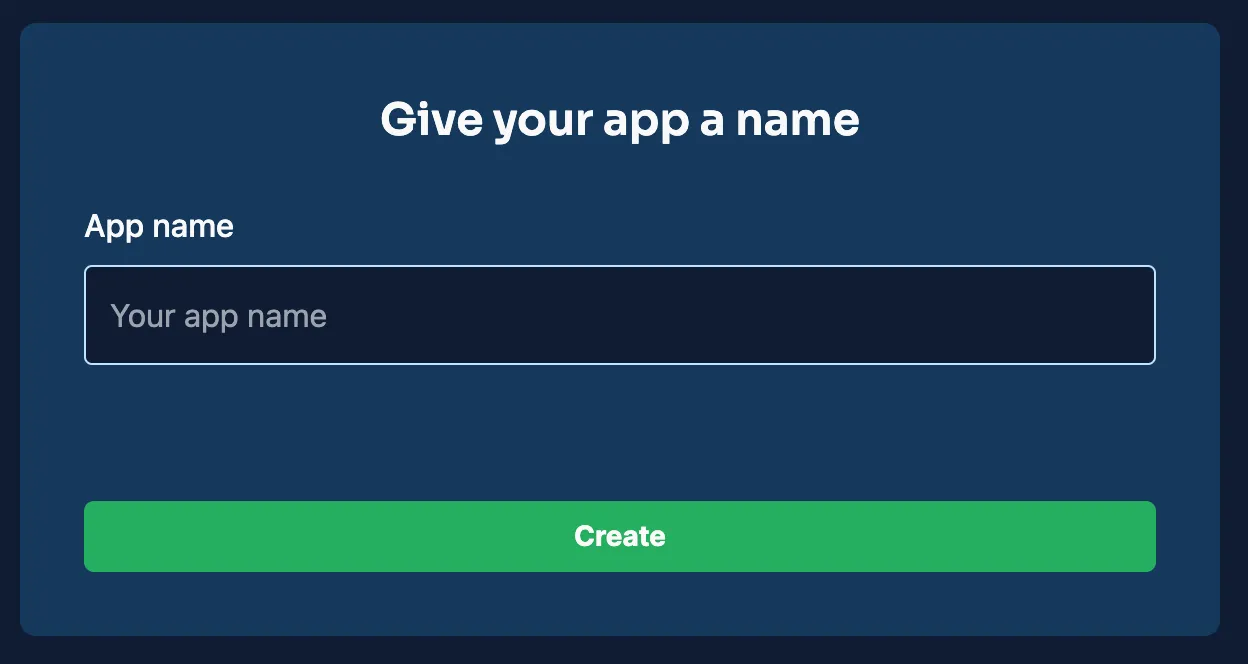
After creating the project, it will appear in your dashboard, laying the foundation for your backend.
For this CRUD application, you'll define multiple collections within your Back4app project. The examples below illustrate the core collections and their fields necessary for CRUD functionality.
This collection stores details about each item.
Field | Data Type | Description |
|---|---|---|
_id | ObjectId | Automatically generated unique ID. |
title | String | The item's name. |
description | String | A brief summary of the item. |
createdAt | Date | Timestamp of item creation. |
updatedAt | Date | Timestamp of the last update. |
This collection handles user credentials and authentication data.
Field | Data Type | Description |
|---|---|---|
_id | ObjectId | Automatically generated unique ID. |
username | String | Unique username for the user. |
String | Unique email address. | |
passwordHash | String | Encrypted password for login. |
createdAt | Date | Account creation timestamp. |
updatedAt | Date | Last account update timestamp. |
You can add these collections and fields manually in the Back4app dashboard.
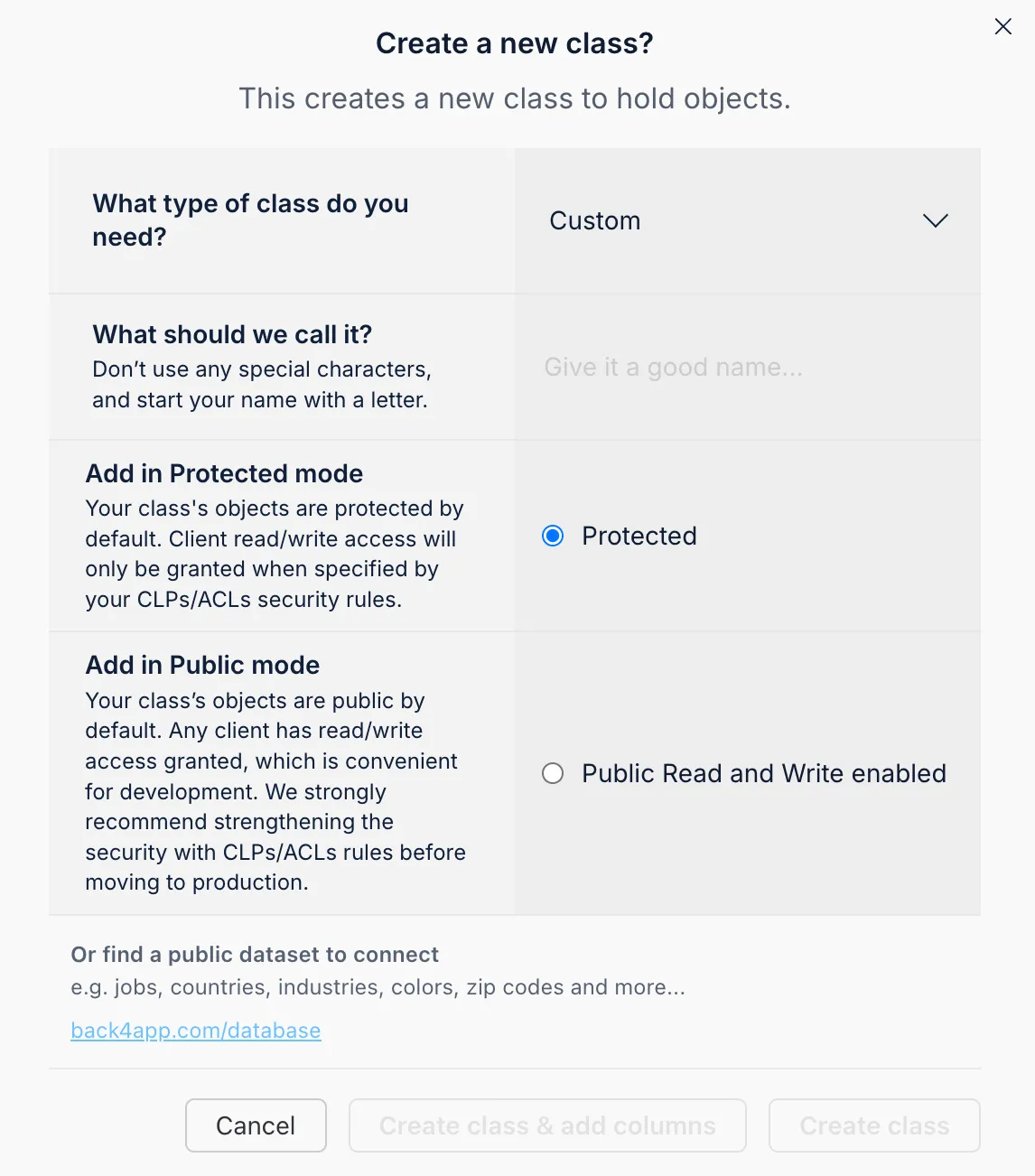
You can add fields by selecting the data type, providing the field name, setting a default value, and marking it as required if necessary.
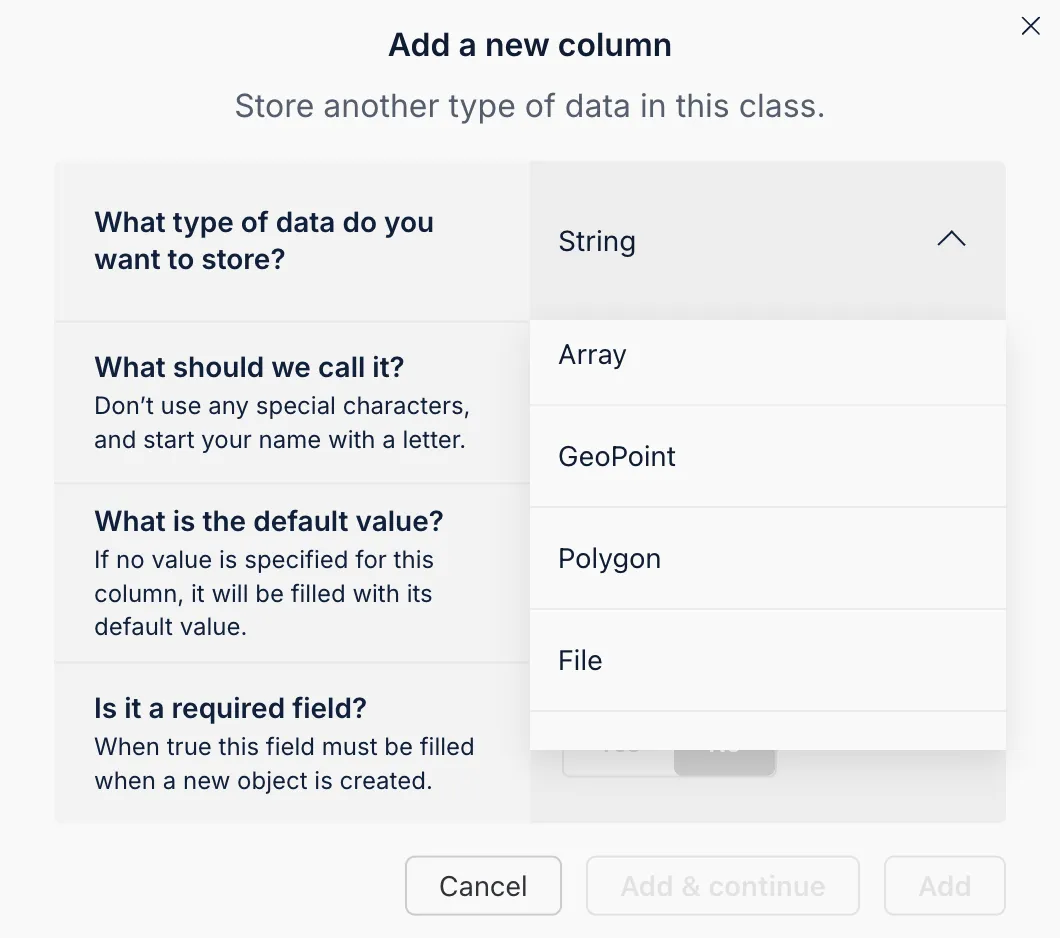
The integrated Back4app AI Agent can automatically generate your data schema based on your description. This tool speeds up setup and ensures your model meets the CRUD requirements.
- Open the AI Agent: Log in to your Back4app dashboard and navigate to the AI Agent in your project settings.
- Describe Your Data Model: Input a detailed prompt describing the collections and fields you need.
- Review and Confirm: Once the AI Agent generates a proposed schema, review it and confirm to implement the configuration.
This AI-driven approach saves time and ensures an optimized and consistent data model.
The Back4app Admin App provides a no-code interface for backend management. With its drag and drop features, you can effortlessly perform CRUD operations such as creating, reading, updating, and deleting records.
- Go to the “More” menu in your Back4app dashboard.
- Select “Admin App” and click “Enable Admin App.”
- Set up admin credentials by creating your first admin account. This process also establishes roles (like B4aAdminUser) and system collections.
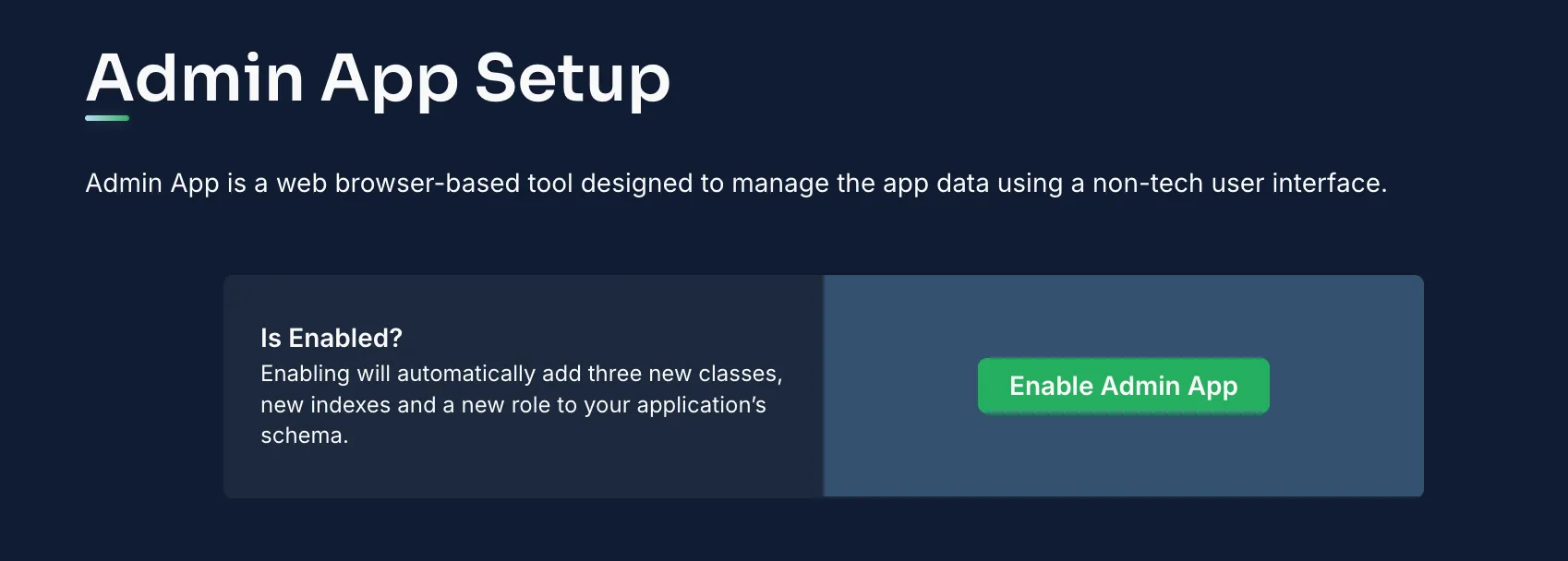
After enabling, log in to the Admin App to start managing your data.
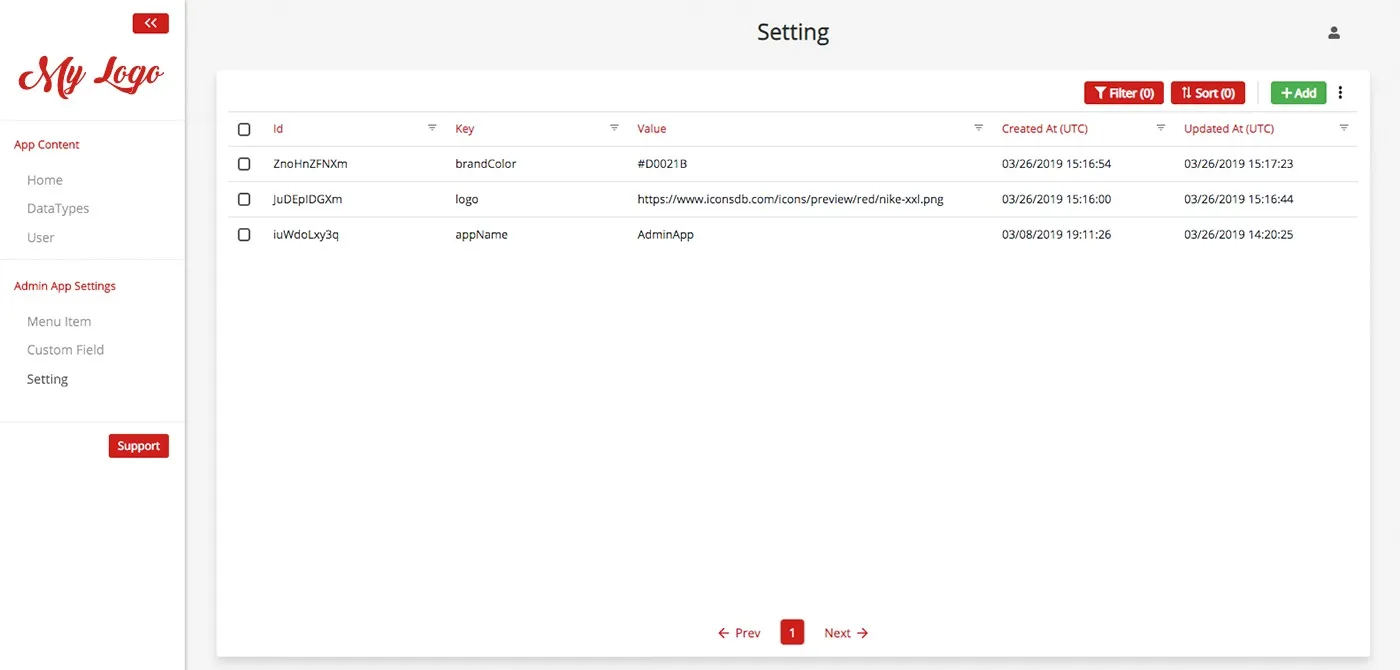
Inside the Admin App, you can:
- Create New Records: Click “Add Record” in any collection (e.g., Items) to insert new data.
- Edit or View Records: Select a record to view its details or modify its fields.
- Delete Records: Remove records that are no longer needed.
This interface simplifies data handling and improves the overall user experience.
Once your backend is ready, it's time to link your Vue.js app with Back4app.
We will use REST API calls via axios to perform CRUD operations.
Install Axios: Run the following command in your project directory:
Bash1npm install axiosSet Up Axios: Create an axios instance in a file (e.g., api.js):
JS1// api.js 2import axios from 'axios'; 3 4const apiClient = axios.create({ 5 baseURL: 'https://parseapi.back4app.com', 6 headers: { 7 'X-Parse-Application-Id': 'YOUR_APPLICATION_ID', 8 'X-Parse-REST-API-Key': 'YOUR_REST_API_KEY', 9 'Content-Type': 'application/json' 10 } 11}); 12 13export default apiClient;Implement CRUD Methods in Vue Components: Here’s an example of how to fetch and create items:
JS1// ItemsService.js 2import apiClient from './api'; 3 4export default { 5 fetchItems() { 6 return apiClient.get('/classes/Items') 7 .then(response => response.data.results) 8 .catch(error => console.error('Error fetching items:', error)); 9 }, 10 11 addItem(title, description) { 12 return apiClient.post('/classes/Items', { 13 title, 14 description 15 }) 16 .then(response => response.data) 17 .catch(error => console.error('Error adding item:', error)); 18 }, 19 20 updateItem(objectId, title, description) { 21 return apiClient.put(`/classes/Items/${objectId}`, { 22 title, 23 description 24 }) 25 .then(response => response.data) 26 .catch(error => console.error('Error updating item:', error)); 27 }, 28 29 deleteItem(objectId) { 30 return apiClient.delete(`/classes/Items/${objectId}`) 31 .then(response => response.data) 32 .catch(error => console.error('Error deleting item:', error)); 33 } 34};
Integrate these API methods into your Vue components to manage your app’s data.
Protect your data by setting up ACLs for your records. For instance, to create an item that only its owner can view or modify:
Use your Back4app dashboard to configure CLPs so that only authenticated users can access certain collections. This ensures that your backend remains secure by default.
Back4app leverages a built-in Users collection for authentication. In your Vue.js app, you can manage user sign-up and login using REST API calls. Here's how:
This setup also allows you to handle session management, password resets, and additional authentication features.
Back4app simplifies the deployment process. You can deploy your Vue.js application using various methods, including Docker containerization.
Compile and Bundle: Use the Vue CLI to compile your app:
Bash1npm run build- Review the Build: Confirm that the output folder (usually dist/) contains all necessary files.
A common Vue.js project structure might look like:
If you prefer containerized deployment, include a Dockerfile at your project root:
- Connect Your GitHub Repository: Ensure your Vue.js project is hosted on GitHub.
- Configure Deployment: In the Back4app dashboard, select the Web Deployment option, link your repository (e.g., Basic-CRUD-App-Vue), and pick the desired branch.
- Set Build Commands: Specify your build command (e.g., npm run build) and indicate the output folder (e.g., dist).
- Deploy: Click Deploy and watch the logs until your app goes live.
Congratulations! You've built a Vue.js-based CRUD application integrated with Back4app.
You configured a project named Basic-CRUD-App-Vue, set up collections for Items and Users, and used the Back4app Admin App for data management.
Additionally, you connected your Vue.js frontend via REST API calls and established security measures.
Next Steps:
- Expand Your Application: Incorporate features such as advanced filtering, detailed item views, or live updates.
- Enhance Backend Functionality: Explore cloud functions, integrate external APIs, or implement role-based access controls.
- Keep Learning: Refer to the Back4app documentation and additional resources to further refine your app.
Happy coding and enjoy building your Vue.js CRUD application!
